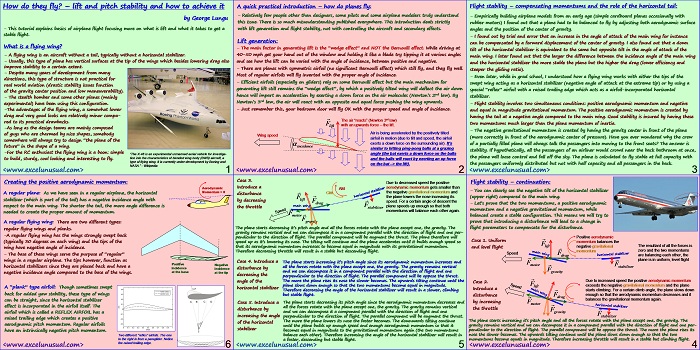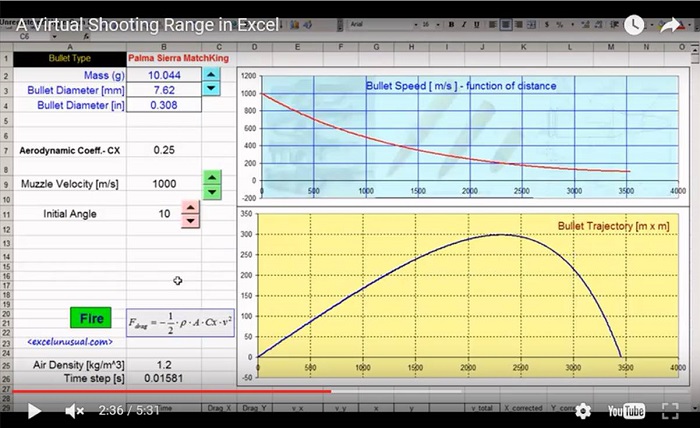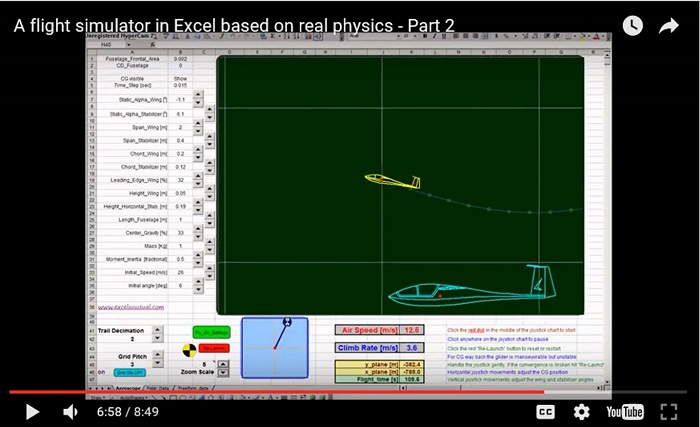Have you ever wondered why the flight attendants of a half empty airliner talk people into moving to the front half of the plane?
Have you ever wondered why a flying wing can fly without a tail or why the stability of some of these flying wing can be controlled only by computer?
Or why a 12 pack stored in at the back of a Cessna can make the plane unstable to the point of precipitating a crash…
It all has to do with two momentums that act on a plane, a positive aerodynamic pitch momentum and a negative gravitation momentum which need to balance each other during the flight.
![]()
How do they fly? – lift and pitch stability and how to achieve it
by George Lungu
– This tutorial explains basics of airplane flight focusing more on what is lift and what it takes to get a
stable flight.
What is a flying wing?
– A flying wing is an aircraft without a tail, typically without a horizontal stabilizer.
– Usually, this type of plane has vertical surfaces at the tip of the wings which besides lowering drag also
improve stability to a certain extent.
– Despite many years of development from many
directions, this type of structure is not practical for
real world aviation (drastic stability issues function
of the gravity center position and low maneuverability).
– The stealth bomber and some other planes (mainly
experimental) have been using this configuration.
-The advantages of the flying wing, a somewhat lower
drag and very good looks are relatively minor compa-
red to its practical drawbacks.
-As long as the design teams are mainly composed
of guys who are charmed by nice shapes, somebody
somewhere will always try to design “the plane of the
future” in the shape of a wing.
-For the RC enthusiast the flying wing is a boon: simple
“The X-48 is an experimental unmanned aerial vehicle for investigation into the characteristics of blended wing body (BWB) aircraft, a type of flying wing. It is currently under development by Boeing and
NASA.” – Wikipedia
to build, sturdy, cool looking and interesting to fly.
A quick practical introduction – how do planes fly:
– Relatively few people other than designers, some pilots and some airplane modelers truly understand
this issue. There is so much misunderstanding published everywhere. This introduction deals strictly
with lift generation and flight stability, not with controlling the aircraft and secondary effects.
Lift generation:
– The main factor in generating lift is the “wedge effect” and NOT the Bernoulli effect. While driving at
40-50 mph get your hand out of the window and holding it like a blade try tipping it at various angles
and see how the lift can be varied with the angle of incidence, between positive and negative.
– There are planes with symmetric airfoil (no significant Bernoulli effect) which still fly, and they fly well.
Most of regular airfoils will fly inverted with the proper angle of incidence.
– Efficient airfoils (especially on gliders) rely on some Bernoulli effect but the main mechanism for
generating lift still remains the “wedge effect”, by which a positively tilted wing will deflect the air down
hence will impart an acceleration by exerting a down force on the air molecules (Newton’s 2nd law). By
Newton’s 3rd law, the air will react with an opposite and equal force pushing the wing upwards.
– Just remember this, your bedroom door will fly OK with the proper speed and angle of incidence.
The air “reacts” (Newton 3rd law)
F with an upwards force – the lift.
lift
Air is being accelerated by the positively tilted
Wing speed
airfoil in motion (due to tilt and speed, the airfoil
exerts a down force on the surrounding air). It’s
incidence
similar to hitting ping-pong balls at a grazing
angle (the bat exerts a down force on the balls
and the balls will react by exerting an up force
on the bat -> the lift).
Flight stability – compensating momentums and the role of the horizontal tail:
– Empirically building airplane models from an early age (simple cardboard planes occasionally with
rubber motors) I found out that a plane had to be balanced to fly by adjusting both aerodynamic surface
angles and the position of the center of gravity.
– I found out by trial and error that an increase in the angle of attack of the main wing for instance
can be compensated by a forward displacement of the center of gravity. I also found out that a down
tilt of the horizontal stabilizer is equivalent to the same but opposite tilt in the angle of attack of the
main wing. I later found out that the larger the difference between the incidence angle of the main wing
and the horizontal stabilizer the more stable the plane but the higher the drag (lower efficiency and
steeper the gliding ratio).
– Even later, while in grad school, I understood how a flying wing works with either the tips of the
swept wing acting as a horizontal stabilizer (negative angle of attack at the extreme tip) or by using a
special “reflex” airfoil with a raised trailing edge which acts as a airfoil-incorporated horizontal
stabilizer.
– Flight stability involves two simultaneous conditions: positive aerodynamic momentum and negative
and equal in magnitude gravitational momentum. The positive aerodynamic momentum is created by
having the tail at a negative angle compared to the main wing. Good stability is insured by having these
two momentums much larger than the plane momentum of inertia.
– The negative gravitational momentum is created by having the gravity center in front of the plane
(more correctly in front of the aerodynamic center of pressure). Have you ever wondered why the crew
of a partially filled plane will always talk the passengers into moving to the front seats? The answer is
stability. If hypothetically, all the passengers of an airliner would crowd near the back bathroom at once,
the plane will loose control and fall off the sky. The plane is calculated to fly stable at full capacity with
the passengers uniformly distributed but not with half capacity and all passengers in the back.
Flight stability – continuation:
– You can clearly see the negative tilt of the horizontal stabilizer
(upper right) compared to the main wing.
– Let’s prove that the two momentums, a positive aerodynamic
momentum and a negative gravitational momentum, while
balanced create a stable configuration. This means we will try to
prove that introducing a disturbance will lead to a change in
flight parameters to compensate for the disturbance.
Positive aerodynamic
Case 1. Uniform momentum balances the lift negative gravitational The resultant of all the forces is and level flight zero and the two momentums momentum drag are balancing each other, the plane is in uniform, level flightmotor stabilizer
Due to increased speed the positive aerodynamic momentum
Case 2.
exceeds the negative gravitational momentum and the plane
lift
Introduce a
starts climbing. For a certain climb angle, the plane slows down
disturbance F enough so that the aerodynamic momentum decreases and it
drag
balances the gravitational momentum again.
by increasing F
motor
the throttle
gravity
stabilizer
The plane starts increasing it’s pitch angle and all the forces rotate with the plane except one, the gravity. The
gravity remains vertical and we can decompose it in a component parallel with the direction of flight and one per-
pendicular to the direction of flight. The parallel component will be oppose the thrust. The more the plane rises its
nose the slower becomes. The upwards tilting continue until the plane slows down enough so that the two
momentums become equals in magnitude. Therefore increasing throttle will result in a stable but climbing flight.
Case 3.
Due to decreased speed the positive
Introduce a aerodynamic momentum gets smaller than
the negative gravitational momentum and
disturbance
the plane lowers the nose increasing its
by decreasing lift
F speed. For a certain angle of descent the
drag
main wing F plane speeds up enough so that both
the throttle stabilizer
momentums will balance each other again.
motor
gravity
The plane starts decreasing it’s pitch angle and all the forces rotate with the plane except one, the gravity. The
gravity remains vertical and we can decompose it in a component parallel with the direction of flight and one per-
pendicular to the direction of flight.
The parallel component will be augment the thrust.
The plane therefore will
speed up as it’s lowering its nose. The tilting will continue and the plane accelerates until it builds enough speed so
that its aerodynamic momentum increases to become equal in magnitude with its gravitational momentum.
Therefore decreasing throttle will result in a stable but descending flight.
Case 4. Introduce a The plane starts increasing it’s pitch angle since its aerodynamic momentum increases and
all the forces rotate with the plane except one, the gravity. The gravity remains vertical
disturbance by
and we can decompose it in a component parallel with the direction of flight and one
decreasing the
perpendicular to the direction of flight. The parallel component will be oppose the thrust.
angle of the The more the plane rises its nose the slower becomes. The upwards tilting continue until the
plane slows down enough so that the two momentums become equal in magnitude.
horizontal stabilizer
Therefore decreasing the angle of the horizontal stabilizer will result in a slower, climbing
but stable flight.
Case 5. Introduce a The plane starts decreasing its pitch angle since the aerodynamic momentum decreases and
all the forces rotate with the plane except one, the gravity. The gravity remains vertical
disturbance by
and we can decompose it a component parallel with the direction of flight and one
increasing the angle perpendicular to the direction of flight. The parallel component will be augment the thrust.
The more the plane lowers its nose the faster becomes. The downwards tilting continue
of the horizontal
until the plane builds up enough speed and enough aerodynamic momentum so that it
stabilizer
becomes equal in magnitude to the gravitational momentum again (the two momentums
balance each other). Therefore increasing the angle of the horizontal stabilizer will result in
a faster, descending but stable flight.
Creating the positive aerodynamic momentum:
Aerodynamic
Momentum > 0
A regular plane: As we have seen in a regular airplane, the horizontal
stabilizer (which is part of the tail) has a negative incidence angle with
respect to the main wing. The shorter the tail, the more angle difference is
needed to create the proper amount of momentum.
A regular flying wing: There are two different types:
regular flying wings and planks.
-A regular flying wing has the wings strongly swept back
(typically 30 degrees on each wing) and the tips of the
wing have negative angle of incidence.
– The base of these wings serve the purpose of “regular”
wings in a regular airplane. The tips however, function as
Positive Negative
horizontal stabilizers since they are placed back and have a
incidence incidence
negative incidence angle compared to the base of the wings. at the base at the tip
A “plank” type airfoil: Though sometimes swept
back for added yaw stability, these type of wings
can be straight, since the horizontal stabilizer
effect is incorporated in the airfoil itself. The
airfoil which is called a REFLEX AIRFOIL has a
raised trailing edge which creates a positive
aerodynamic pitch momentum. Regular airfoils
have an intrinsically negative pitch momentum.
Two different “reflex” airfoils. The one
to the right is from a paraglider. Notice
the raised trailing edge.



I never heard the first quote before :-). That’s so true.
OK George
Maybe Einstein was on your side with attributed quotes such as
“The only thing that interferes with my learning is my education” and the one I believe in, “Everything should be made as simple as possible, but no simpler.”
For me, insight and understanding count for everything; learning and memory provide poor substitutes – although they may offer a few shortcuts.
I observed a huge change in my understanding and capacity of solving problems. I am talking huge. I am trying to convey this in here. Cheers, George
Point of correction: In a number of cases you have used ‘momentum’ (mass x velocity) where I think you mean ‘moment’ (force x distance).
Point for discussion: I am not an aerodynamicist but I suspect the ‘wedge effect’ you offer as an aid to visualising aerodynamic lift is not as distinct from the Bernoulli effect as you suggest. The bedroom door will generate lift so the force on the underside is greater than that on the topside. On a streamline this, in turn, tells you that the velocity on the underside is lower and that there is circulation about the door, so one would expect to see vortices created. Even a particle model such as your bat and flow of ping pong balls would have the bat decreasing the momentum of the ping pong balls it strikes.
The shape of the aerofoil also has an effect but I think your point is that the effect is not essential to the understanding of lift as an aerodynamic force.
It all goes like this: wedge = deflects air down (both top and bottom of the wing), changes impulse of air particles down. By Newton’s 3rd law the same but opposite impulse is experienced by the wing. Newton 2nd law: impulse change => acceleration => force => lift. Of course the sape makes a huge diference (1-2 orders of magnitude in efficiency) but that is a secondary effect – later on that one. All you said it’s true but about that, later… There is some Bernoully there also but it’s not the main factor.